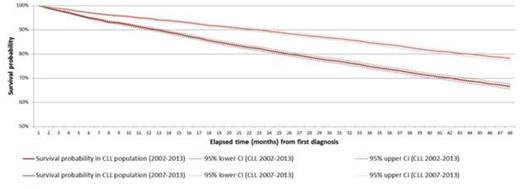Abstract
Background: Real-world evidence based analyses are gaining importance worldwide. They are especially useful to inform medical/scientific evidence setting, health policy decision-making, or health-economic modelling. Due to legislation for data of public interest set in Act LXIII of 2012, health care data recorded by the predominantly state-owned health insurance system are accessible in Hungary. The National Health Insurance Fund Administration (NHIFA) as single payer covers the total population of 10 million inhabitants, providing de-identified patient data on health care resource utilization and demographics upon request.
Chronic lymphocytic leukaemia is an adult haematological malignancy. New therapies, e.g. BTKs need to find their place in therapy but the currently available information in Hungary on epidemiology, patient pathways and characteristics on population level are scarce.
Aim: During the last decade numerous novel therapeutic options became available. Mortality as an important treatment outcome is of interest to understand any impact these novel agents may have. We evaluated overall survival during the period from 2000 – 2013 with the hypothesis that survival rate is strongly correlated with time of first diagnosis and subsequently availability of appropriate therapies.
Methods: As part of a larger project called LYRICS (Lymphoma Real-Life Insight Core Survey) we have conducted a comprehensive retrospective analysis based on the NHIFA's database to map the CLL therapy landscape and outcomes in the last 14 years. The basis of the analysis was the claims database of inpatient and outpatient care (DRG based financing) and outpatient drug reimbursement system. Mortality rates were studied by non-parametric (Kaplan-Meier survival analysis) and semi-parametric (Cox proportional hazard regression) approaches.
Results:The annual number of prevalent CLL patients is 3-4,000 with 8-900 newly diagnosed patients annually. The assessment was based on at least two relevant and confirmed C91.10 ICD diagnoses in inpatient or outpatient care. Kaplan-Meier curve estimates show the median overall survival from diagnosis is 80 months.
The survival probability at one elapsed year is 91% in CLL patients diagnosed between the years 2002-2013, and 95% in the years between 2007-2013. The 4-year survival probability is 67% for patients diagnosed between the years of 2002-2013 and 78% for patients diagnosed between the years 2007-2013 (Figure 1 below).
By fitting Cox model with age covariates, it can be shown that there is significant difference in relative risk (RR) of death in different age cohorts. The RR of death in the 60-69 age cohort is 1.5 times and in the 70-79 age cohort is more than 2 times higher than in the 50-59 age cohort of CLL patients.
Conclusion:
These results from this analyses show a significant increase of survival in Hungary over the last 15 years. The availability of treatment options have contributed to this increased survival probability. This population, real-world data confirms the relevance of age at first diagnosis as predictor for overall survival. Recently approved therapies in CLL, e.g. Ibrutinib are expected to further improve the mortality outcome for this patient group.
Gaudig:Janssen : Employment. Vályi-Nagy:Janssen-Cilag Ltd.: Consultancy. Takacs:Janssen-Cilag Ltd. Hungary: Employment. Bacskai:Healthware Consulting Ltd: Equity Ownership. Kozma:Janssen-Cilag Ltd. Hungary: Employment. Rakonczai:Healthware Consulting Ltd: Employment. Püspöki:Healthware Consulting Ltd: Employment.
Author notes
Asterisk with author names denotes non-ASH members.


This feature is available to Subscribers Only
Sign In or Create an Account Close Modal